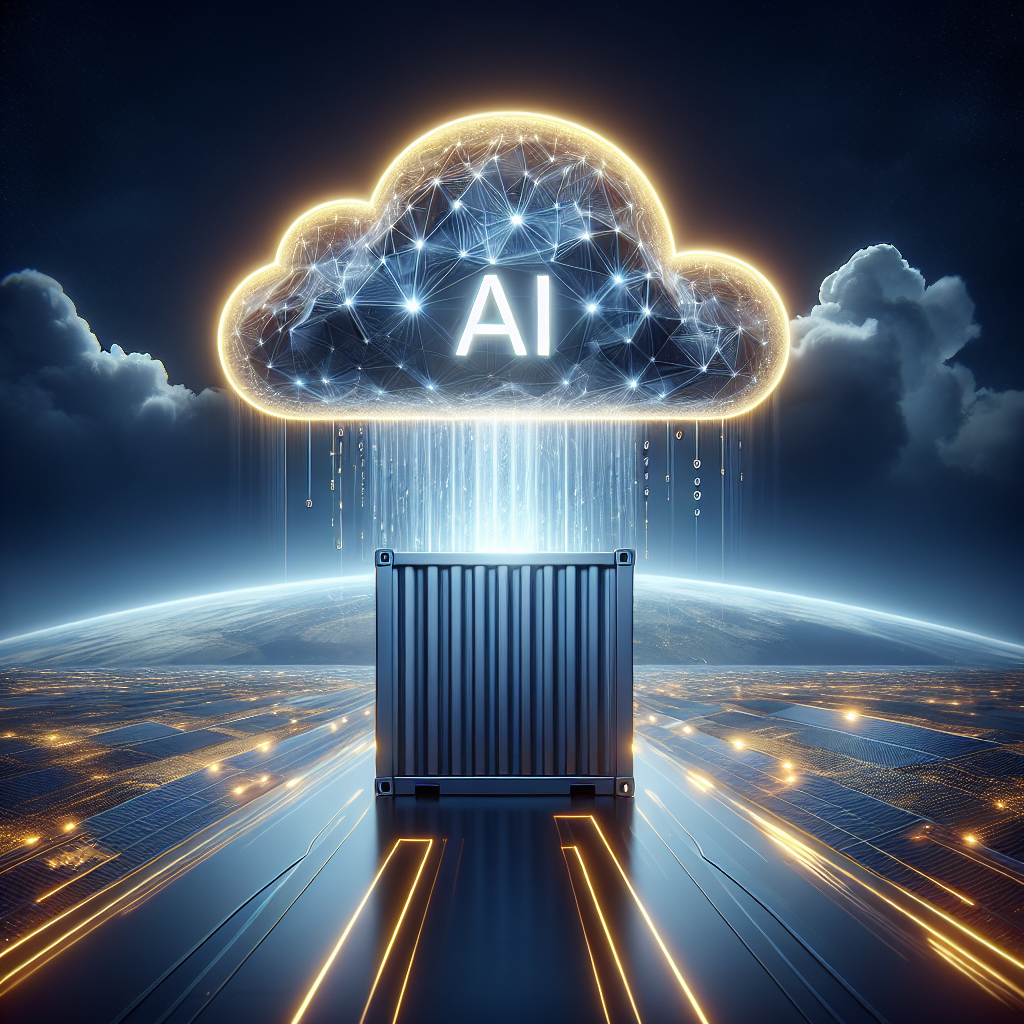Imagine being able to bring the power of Artificial Intelligence (AI) right to the edge of your network with the help of Azure Cognitive Services Containers. With these innovative containers, you can tap into the potential of AI without depending on cloud connectivity. By deploying Cognitive Services Containers on your edge devices, you can unlock a wide range of AI capabilities such as image recognition, natural language understanding, and speech recognition, all within the confines of your own infrastructure. This article explores how Azure Cognitive Services Containers are transforming the way we harness AI at the edge, making it more accessible and efficient than ever before.

Azure Cognitive Services Containers
What are Azure Cognitive Services Containers?
Azure Cognitive Services Containers are pre-built and portable containers that allow you to bring artificial intelligence (AI) capabilities to the edge of your network. These containers encapsulate various cognitive services such as computer vision, speech recognition, natural language processing, and more. By having these containers at the edge, you can process data locally in real-time, enabling faster responses and minimizing the need for constant back-and-forth communication with the cloud.
Benefits of using Azure Cognitive Services Containers
There are several benefits to using Azure Cognitive Services Containers. Firstly, they provide offline capabilities, which is crucial for scenarios where internet connectivity may be limited or unreliable. By bringing AI capabilities to the edge, you can ensure continuous operation even when the network is unavailable.
Secondly, Azure Cognitive Services Containers enable low-latency processing. Since the data is analyzed locally, there is no latency caused by sending data to the cloud for processing and waiting for a response. This is particularly important for time-sensitive applications that require real-time decision-making.
Additionally, using containers allows for easy deployment and scalability. Containers provide a consistent environment for running the cognitive services, ensuring compatibility across different edge devices and platforms. They can be deployed on various hardware, such as IoT devices and edge servers, making it flexible for different use cases and environments.
Different types of Azure Cognitive Services Containers
Azure Cognitive Services Containers offer a range of cognitive services that can be deployed at the edge. Some of the key types of containers include:
-
Computer Vision Container: This container enables tasks such as image recognition, object detection, and image analysis. It can be used for applications like security surveillance, augmented reality, and autonomous vehicles.
-
Speech Container: The speech container enables speech-to-text transcription, text-to-speech synthesis, and language understanding. It is useful for voice assistants, call centers, and transcription services.
-
Natural Language Processing (NLP) Container: This container allows for sentiment analysis, entity recognition, language translation, and more. It can be used for chatbots, customer support, and content analysis.
-
Custom Containers: Azure Cognitive Services also allows you to create custom containers, giving you the flexibility to deploy your own AI models or extend the existing cognitive services with your specific requirements.
AI at the Edge
What is AI at the Edge?
AI at the Edge refers to the practice of deploying and running AI algorithms and models directly on edge devices or edge servers, rather than relying solely on cloud-based AI solutions. This brings AI capabilities closer to the source of data generation, allowing for real-time processing and decision-making without the need for constant connectivity to the cloud.
By bringing AI to the edge, organizations can leverage the power of AI in scenarios where low latency, data privacy, and offline capabilities are essential. The edge devices can process and analyze data locally, reducing the dependence on cloud infrastructure and enabling faster responses.
Advantages of bringing AI to the Edge
Bringing AI to the edge offers several advantages. Firstly, it enables real-time decision-making. By processing data locally, AI algorithms can provide immediate responses, minimizing latency and enhancing the overall user experience. This is particularly important for applications such as autonomous vehicles, industrial automation, and remote monitoring.
Secondly, AI at the edge reduces dependence on cloud connectivity. In scenarios where internet connectivity is limited, unstable, or expensive, having AI capabilities at the edge ensures uninterrupted operation. This is crucial for applications in remote areas, maritime environments, and situations where the cost of network data transmission is a concern.
Furthermore, AI at the edge addresses data privacy and security concerns. By processing sensitive data locally, organizations can maintain control over their data and avoid transmitting it to the cloud. This is particularly important for industries such as healthcare and finance, where data privacy regulations and security requirements are stringent.
Challenges of implementing AI at the Edge
While there are numerous benefits to implementing AI at the edge, there are also some challenges to consider. Firstly, edge devices typically have limited computational resources, such as memory and processing power. This can pose challenges when running complex AI models that require substantial resources. However, advances in edge hardware technology and optimization techniques are mitigating this challenge.
Secondly, updating and managing AI models at the edge can be challenging. Edge devices are often distributed across different locations, making it difficult to update and maintain consistency across all devices. Furthermore, the deployment and management of containers and models may require specialized technical skills and tools.
Lastly, ensuring data quality and accuracy at the edge can be a challenge. Edge devices may encounter variations in data quality, such as noise or environmental factors. Ensuring accurate AI predictions in such scenarios can be complex, requiring robust data preprocessing techniques and model calibration.

Bringing AI to the Edge with Azure Cognitive Services Containers
Understanding the concept of bringing AI to the Edge with Azure Cognitive Services Containers
Bringing AI to the Edge with Azure Cognitive Services Containers involves deploying pre-built and portable containers that contain AI capabilities directly on edge devices or edge servers. These containers encapsulate the required cognitive services, making it easier to deploy and run AI algorithms at the edge.
With Azure Cognitive Services Containers, organizations can leverage the power of AI on the edge while benefiting from the scalability, security, and compatibility of Azure services. This approach enables real-time processing, offline capabilities, and reduced network dependency, all of which are critical in edge scenarios.
How to deploy Azure Cognitive Services Containers at the Edge
Deploying Azure Cognitive Services Containers at the edge involves several steps. Firstly, you need to choose the appropriate Azure Cognitive Services Container for your specific use case. Consider the type of cognitive service, such as computer vision or speech, that aligns with your desired edge application.
Next, determine the hardware or edge platform on which you want to deploy the containers. Azure Cognitive Services Containers can be deployed on a wide range of devices, including IoT devices, edge servers, and even laptops. Ensure that your chosen hardware or platform meets the minimum requirements for running the containers and has the necessary connectivity options.
Once you have chosen the container and hardware, the next step is to set up Azure Cognitive Services. This involves creating an Azure account, configuring the cognitive services you require, and obtaining the required credentials and API keys.
Lastly, deploy the Azure Cognitive Services Containers to the edge devices or edge servers. Follow the deployment instructions provided by Azure Cognitive Services to ensure a seamless and successful deployment. Monitor the deployment to ensure proper functioning and make any necessary adjustments or updates as required.
Integration with Edge devices and platforms
Azure Cognitive Services Containers can be integrated with a variety of edge devices and platforms. The containers are designed to be platform-agnostic, enabling compatibility with different hardware and operating systems.
For IoT devices, Azure Cognitive Services Containers can be deployed using Azure IoT Edge. Azure IoT Edge is a managed service that enables the deployment and management of containers on edge devices. It provides features such as edge analytics, device management, and secure communication with the cloud.
For edge servers or other non-IoT edge devices, Azure Cognitive Services Containers can be deployed using container orchestration platforms like Kubernetes. These platforms provide robust management, scaling, and load balancing capabilities for containers across multiple edge servers.
Integration with edge devices and platforms is crucial for maximizing the benefits of AI at the edge. It allows for centralized management, efficient resource utilization, and seamless scalability across a large number of edge devices.
Use Cases for AI at the Edge with Azure Cognitive Services Containers
Enhancing real-time video analytics with AI at the Edge
Real-time video analytics is a common use case for AI at the edge with Azure Cognitive Services Containers. By deploying the computer vision container on edge devices, organizations can process video feeds in real-time and extract valuable insights. This enables applications such as surveillance systems, smart city solutions, and industrial monitoring.
For example, in a retail setting, the computer vision container can analyze video footage from in-store cameras and detect customer behavior patterns. This can help optimize store layouts, improve customer engagement, and enhance security. With AI at the edge, these insights can be generated instantaneously, ensuring timely actions and minimizing response time.
Enabling intelligent IoT devices with Azure Cognitive Services Containers
Intelligent IoT devices are another key use case for AI at the edge with Azure Cognitive Services Containers. By deploying cognitive services such as speech recognition, natural language processing, and anomaly detection on IoT devices, organizations can enhance their functionality and enable intelligent interactions.
For instance, in the healthcare industry, wearable devices equipped with Azure Cognitive Services Containers can provide real-time health monitoring and analysis. The devices can detect abnormalities in vital signs, analyze speech patterns, and provide personalized recommendations or alerts. This enables proactive healthcare management and empowers individuals to take timely actions.
Improving natural language processing at the Edge
Natural language processing (NLP) is a critical component of many AI applications, and bringing NLP to the edge offers significant advantages. With Azure Cognitive Services Containers, organizations can deploy the NLP container on edge devices to enable real-time language understanding and sentiment analysis.
An example use case is a chatbot deployed on a customer service kiosk. By leveraging NLP capabilities at the edge, the chatbot can understand customer inquiries, provide personalized responses, and even detect sentiment-based feedback. This enhances the overall customer experience, reduces latency, and minimizes reliance on cloud connectivity.

Steps to Get Started with Azure Cognitive Services Containers at the Edge
Step 1: Setting up Azure Cognitive Services
To get started with Azure Cognitive Services Containers at the edge, the first step is to set up Azure Cognitive Services. You will need an Azure account to create and configure the cognitive services you require.
Log in to the Azure portal and navigate to the Azure Cognitive Services section. Choose the specific cognitive service you want to use, such as Computer Vision, Speech, or NLP. Follow the instructions to create the service, configure its settings, and obtain the necessary API keys and credentials.
Step 2: Choosing the right Azure Cognitive Services Container
The next step is to choose the appropriate Azure Cognitive Services Container for your use case. Consider the specific cognitive service you want to deploy at the edge, such as Computer Vision, Speech, or NLP.
Once you have identified the container, find the corresponding container image in the Azure Container Registry (ACR). Azure Cognitive Services Containers are available as pre-built container images in the ACR, making it easy to download and deploy.
Step 3: Deploying Azure Cognitive Services Containers to the Edge
To deploy Azure Cognitive Services Containers to the edge, you need to have the appropriate hardware or platform available. Depending on your use case, this could be an IoT device, an edge server, or any other edge device.
Follow the deployment instructions provided by Azure Cognitive Services to ensure a successful deployment. This typically involves pulling the container image from the Azure Container Registry, starting the container on the edge device, and configuring the necessary environment variables and connection settings.
Monitor the deployment to ensure proper functioning and make any necessary adjustments or updates as required. Azure provides tools and services for monitoring and managing edge deployments, enabling efficient troubleshooting and maintenance.
Best Practices and Considerations for AI at the Edge with Azure Cognitive Services Containers
Ensuring security and privacy at the Edge
When deploying AI at the edge with Azure Cognitive Services Containers, it is crucial to prioritize security and privacy. Ensure that the edge devices and platforms used are properly secured and have the necessary safeguards in place.
Consider using encryption mechanisms for data transmission and storage on the edge devices. Implement access control mechanisms to restrict unauthorized access to the containers and sensitive data. Regularly update the containers and edge devices with the latest security patches and firmware updates.
Furthermore, comply with relevant data protection regulations and privacy standards, depending on the industry and geographical location. Understand the guidelines and requirements for handling sensitive data, ensure that user consent is obtained where necessary, and implement appropriate data anonymization or de-identification techniques.
Optimizing performance and latency
To optimize performance and minimize latency, there are several considerations to keep in mind. Firstly, choose the appropriate hardware or edge platform that meets the computational requirements of the AI models and services. Consider factors such as CPU power, memory, and storage capacity when selecting edge devices.
Additionally, optimize the AI models and containers for efficient resource utilization. Techniques such as model compression, quantization, and pruning can reduce the computational and memory requirements without significantly sacrificing performance.
Furthermore, consider the data preprocessing and feature extraction steps. Preprocess the data at the edge to reduce the amount of data transmitted and minimize the processing required by the AI models. This can help reduce latency and ensure efficient use of edge device resources.
Monitoring and managing Edge deployments
Monitoring and managing edge deployments is crucial for ensuring optimal performance and reliability. Azure provides various tools and services for monitoring and managing Azure Cognitive Services Containers at the edge.
Leverage Azure Monitor to collect and analyze telemetry data from the edge devices. Monitor metrics such as CPU usage, memory consumption, and network throughput to identify any performance bottlenecks or anomalies.
Additionally, use Azure IoT Hub or Azure IoT Central to manage and monitor edge devices at scale. These services provide features such as device provisioning, remote management, and over-the-air updates. They enable centralized control and simplify the deployment and maintenance of Azure Cognitive Services Containers on a large number of edge devices.
Regularly review the monitoring data and logs to detect any issues or deviations from expected behavior. Set up alerts and notifications to proactively respond to any critical events or failures. Establish efficient processes for debugging, troubleshooting, and updating the containers and models running at the edge.

Future Trends and Opportunities for AI at the Edge with Azure Cognitive Services Containers
Emerging technologies for Edge AI
As AI at the edge continues to evolve, several emerging technologies hold promise for future advancements. One such technology is edge computing, which enables data processing and analytics to be performed at the edge devices themselves. Edge computing reduces the reliance on cloud infrastructure and provides faster response times.
Another emerging technology is federated learning, which allows AI models to be trained collaboratively on edge devices without the need to transfer raw data to the cloud. Federated learning enables privacy-preserving machine learning and enables AI models to be trained using data from various edge devices while preserving data privacy.
Applications in industries such as healthcare, manufacturing, and retail
AI at the edge with Azure Cognitive Services Containers has vast applications across various industries. In healthcare, it can enable remote patient monitoring, personalized care recommendations, and real-time analysis of medical images. In the manufacturing sector, it can enhance quality control, predictive maintenance, and autonomous robotics. In the retail industry, it can improve inventory management, customer experience, and personalized marketing.
Moreover, industries such as transportation, agriculture, and energy are poised to benefit from AI at the edge. Autonomous vehicles, precision agriculture, and smart grid management are just a few examples of how AI at the edge can revolutionize these sectors, enabling more efficient operations and reducing costs.
Potential impacts on business processes and customer experiences
The adoption of AI at the edge with Azure Cognitive Services Containers can have profound impacts on business processes and customer experiences. With real-time processing and low-latency decision-making, organizations can streamline operations, reduce manual tasks, and improve overall efficiency.
Additionally, bringing AI to the edge allows for context-aware and personalized customer experiences. By analyzing data on the edge devices, AI algorithms can understand individual preferences, make relevant recommendations, and provide tailored services. This enhances customer satisfaction, loyalty, and ultimately, drives business growth.
Conclusion
Azure Cognitive Services Containers offer a powerful solution for bringing AI to the edge, enabling real-time processing, offline capabilities, and reduced network dependency. By deploying Azure Cognitive Services Containers on edge devices or edge servers, organizations can unlock the full potential of AI in scenarios where low latency, data privacy, and continuous operation are critical.
With benefits such as enhanced real-time video analytics, intelligent IoT devices, and improved natural language processing, AI at the edge with Azure Cognitive Services Containers has a wide range of applications across industries. By following best practices and considerations for security, performance optimization, and monitoring, organizations can ensure successful deployments and unlock the full potential of AI at the edge.
As emerging technologies continue to shape the field of AI at the edge, the future holds immense opportunities for industries such as healthcare, manufacturing, and retail. By leveraging Azure Cognitive Services Containers, organizations can drive innovation, improve business processes, and deliver exceptional customer experiences in the era of AI at the edge.

